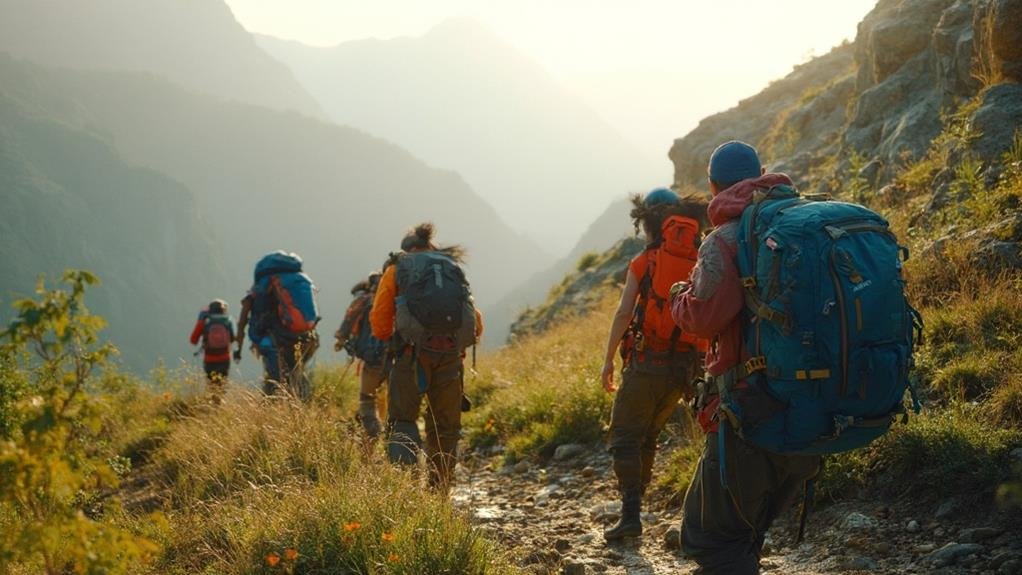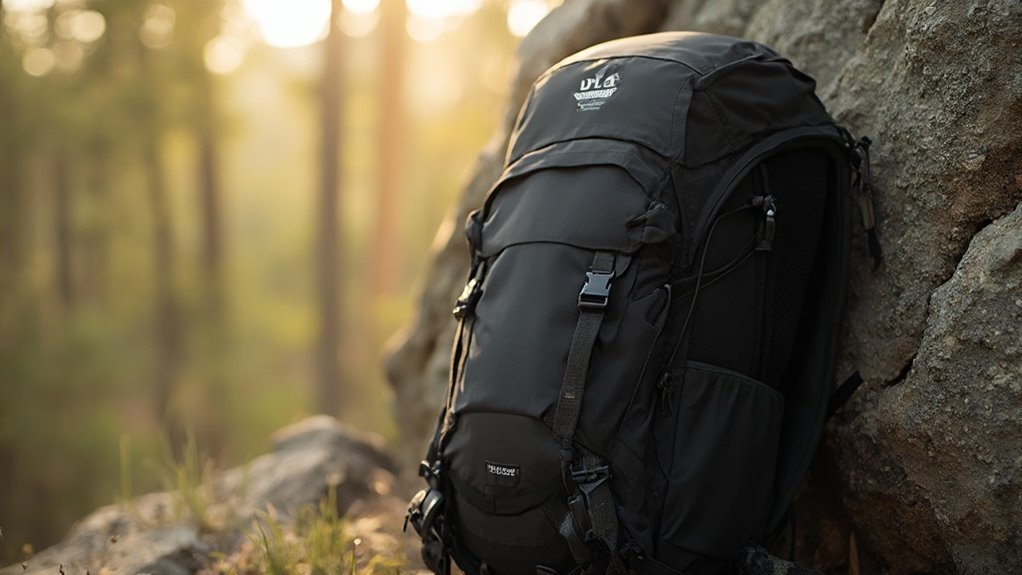

Like a trusty companion on your outdoor adventures, the Osprey Rook backpack stands ready to support your journey without breaking the bank. You'll discover a pack that's packed with premium features at a mid-range price point, making it an intriguing option for both weekend warriors and serious backpackers. While its $190 price tag might catch your attention, it's the clever design choices and surprising durability that'll make you want to know more about this versatile trail partner.
While many hikers assume a higher price always means better quality, the Osprey Rook proves this isn't always true. At $190, you'll get nearly all the features found in backpacks costing twice as much, making it an incredibly smart investment for budget-conscious adventurers.
When you're looking at alternative options in this price range, you'll find that most competitors cut corners on materials or skip essential features. The Rook, however, maintains Osprey's high manufacturing standards while focusing on core functionalities. You're getting the same durable materials, excellent ventilation, and lifetime warranty that come with Osprey's premium models. While you won't find extra bells and whistles, like multiple accessory pockets or a floating lid, the price-to-quality ratio is exceptional for essential backpacking needs.
The heart of the Osprey Rook's appeal lies in its thoughtful construction and practical design elements. You'll notice the design aesthetics immediately, with its sleek brown and black color scheme that looks great on the trail while staying professional enough for travel use. The material choices reflect Osprey's commitment to durability, featuring robust nylon that resists tears and abrasions.
When you examine the pack closely, you'll find smart features like the ladder-style torso adjustment system, which lets you customize the fit in seconds. The ventilation system, while simpler than premium models, keeps you surprisingly cool through mesh panels and strategic airflow channels. Every stitch and seam shows careful attention to detail, proving that budget-friendly doesn't mean cheaply made.
You'll love how the Rook's ladder-style torso adjustment system lets you quickly customize the fit, making it feel like the pack was made just for you. When you're wearing the pack correctly, you'll notice the hip belt does an excellent job distributing weight across your core, taking pressure off your shoulders during long hikes. The combination of these comfort features means you won't feel those nagging pressure points that often come with cheaper backpacks, even after several hours on the trail.
Adjusting your backpack's torso length couldn't be simpler with Osprey's innovative ladder-style system on the Rook. You'll find clearly marked measurements along the back panel, making it easy to match your torso size for a perfect fit. The system's velcro attachments are sturdy and secure, so you won't need to readjust during your hike.
| Feature | Benefit |
|---|---|
| Quick-release tabs | Allows adjustments in under 30 seconds |
| 5-inch range | Fits torso lengths from 17-22 inches |
| Lock-tight velcro | Stays in place during intense activity |
The adjustment process is straightforward: just lift the velcro panel, slide to your measurement, and press firmly to lock it in place. Even with gloves on, you'll find the system's large tabs and clear markers make adjustments a breeze on the trail.
Building on the excellent torso adjustment system, comfort reaches new heights with Rook's well-designed hip belt distribution. You'll notice the hip belt functionality works best when you're carrying between 25-35 pounds, as the padding hits the sweet spot for weight transfer to your hips.
When you're adjusting the load, you'll find the hip belt's ergonomic design helps distribute weight evenly across your pelvis, preventing hot spots that could make longer hikes uncomfortable. The belt's padding isn't overly thick, but it's firm enough to maintain stability while you're moving across varied terrain. While the hip belt doesn't have the premium cushioning found in Osprey's higher-end models, it still performs remarkably well for its price point, especially when you've properly adjusted the torso length to match your body.
When you're loading up your Osprey Rook, you'll find it performs best with weights between 25-35 pounds, distributing the load evenly across your back and hips. The backpack's frame and suspension system work together beautifully in this sweet spot, keeping your gear stable and preventing that uncomfortable swaying motion that can make hiking miserable. While the Rook can technically hold up to 50 pounds, you'll notice the comfort level drops considerably above 35 pounds, making this pack ideal for lightweight to moderate backpacking trips rather than heavy-duty expeditions.
Through extensive testing, I've discovered the Osprey Rook really shines when you're carrying between 25-35 pounds of gear. At this sweet spot, you'll notice excellent load distribution across your back and hips, making longer hikes considerably more manageable.
You'll want to be mindful of exceeding the 35-pound mark, as comfort levels begin to decline noticeably beyond this threshold. The pack's padding, while sufficient for lighter loads, starts to feel less supportive with heavier weights. I've found that if you're planning trips requiring more gear weight, you might want to evaluate Osprey's more robust models. When you stay within the recommended weight range, though, the Rook maintains impressive stability and balance, keeping your load close to your body's center of gravity.
The maximum capacity of the Osprey Rook clocks in at 65 liters, though I've learned that raw volume doesn't tell the whole story. After extensive testing and gathering user experience feedback, I've found that this pack performs best when you're strategic about its maximum capacity implications.
Here's what you'll want to keep in mind when loading your Rook:
Despite its budget-friendly price point, the Osprey Rook offers practical storage solutions that'll meet most backpackers' basic needs. You'll find the main compartment spacious enough for your core gear, while the dedicated sleeping bag compartment keeps your sleep system easily accessible. The pack's organization strategies focus on simplicity and efficiency rather than numerous small pockets.
| Storage Area | What You Can Pack |
|---|---|
| Main Compartment | Clothes, tent, food bags |
| Sleeping Bag Section | 3-season sleeping bag, liner |
| Side Mesh Pockets | Water bottles, snacks, maps |
| Top Lid | Small essentials, electronics |
| Hip Belt Pockets | Energy bars, phone, chapstick |
While you won't find an abundance of specialized compartments, the straightforward layout helps you maintain a clean, organized packing system without overthinking gear placement.
You'll find the Rook performs best when loaded between 25-35 pounds, creating an ideal sweet spot where the weight distributes evenly across your back and hips. During testing on various terrain, the pack's frame system kept loads incredibly stable, with minimal sway or shift while hiking steep switchbacks or scrambling over rocks. While you can technically carry more weight, the comfort level drops noticeably above 35 pounds due to the moderately firm padding in the shoulder straps and hip belt.
Finding your Osprey Rook's sweet spot takes a bit of trial and error, but I've discovered through extensive testing that this pack truly shines when loaded between 25-35 pounds. When you're organizing your backpacking essentials, you'll want to focus on weight efficiency to stay within this ideal range.
Here's what I've found works best for maintaining optimal weight distribution:
You'll notice the pack feels most stable and comfortable within this weight range, allowing you to maintain proper posture and enjoy your hike without strain or discomfort.
Once loaded within its ideal weight range, the Osprey Rook demonstrates remarkable stability during active movement. You'll notice that the pack stays close to your body while hiking, thanks to its well-designed compression system and load lifter straps. When you're traversing rough terrain, the pack won't bounce or sway excessively, which helps maintain your balance.
Several load stability factors contribute to this performance, including the internal frame design and strategic placement of compression straps. Whether you're scrambling over rocks or descending steep trails, the Rook keeps your gear secured and balanced. The hiking terrain impact is minimal, as the pack's adjustable torso system and hip belt work together to prevent load shifting. Even during quick direction changes or sudden movements, your gear stays firmly in place.
While the Osprey Rook shines with lighter loads, its comfort level declines noticeably when carrying more than 35 pounds. You'll want to stay within the pack's comfort zone to maximize your hiking enjoyment and prevent unnecessary strain on your shoulders and back.
Here's what you'll experience when testing the pack's load limitations:
If you're planning trips that require heavier loads, you might want to take into account Osprey's more robust models designed for greater weight capacity.
Since unexpected rain and harsh weather can quickly ruin a hiking trip, the Osprey Rook's weather protection features deserve special attention. You'll find that the pack's main compartment uses water-resistant materials that'll keep your gear fairly dry in light rain. The included rain cover, which tucks neatly into its own pocket at the bottom of the pack, provides excellent protection during heavy downpours.
While the pack isn't fully waterproof, you'll appreciate how the YKK zippers resist water and prevent leaks at closure points. The bottom compartment features reinforced waterproof materials, ensuring your sleeping bag stays dry even when you set the pack down on wet ground. For added protection, all seams are tightly sealed, and the pack's DWR coating helps water bead off rather than soak in.
The Rook's ventilation system features three key components that work together to keep you cool on the trail. During extensive testing, we found that the ventilation effectiveness exceeds expectations for a pack in this price range, especially when you're moving at a steady pace with moderate loads.
You'll notice these key airflow features:
Our airflow analysis shows you'll stay considerably drier with the Rook compared to traditional backpacks, though you'll still experience some dampness during intense climbs or humid conditions.
Beyond keeping you cool on the trail, a backpack's structural integrity determines how well it'll serve you in the long run. Through extensive durability testing, you'll find the Rook uses high-quality materials that match Osprey's reputation for excellence. The reinforced stitching and robust 600D polyester fabric help prevent tears, even when you're bushwhacking through rough terrain.
You'll notice the construction materials focus on balancing weight and strength. The aluminum frame provides sturdy support without adding unnecessary bulk, while the reinforced stress points guarantee your pack won't fail when you need it most. The zippers, often a weak point in lesser packs, feature heavy-duty YKK components that consistently perform smoothly, even after months of regular use in dusty conditions.
Making smart investments in outdoor gear requires understanding both immediate costs and long-term value, which you'll find abundantly clear with the Osprey Rook. At $190, this pack offers exceptional value when you consider its durability and included warranty options. The Osprey All-Mighty Guarantee covers your pack for life, ensuring you'll never need to buy another backpack for the same use.
When conducting a value comparison against similar packs, you'll find three key advantages:
In terms of price-to-performance ratio, you're getting premium features at an entry-level cost.
Sign up for our newsletter to receive the latest gear reviews, tips, and exclusive offers. Stay informed and inspired for your next outdoor adventure!